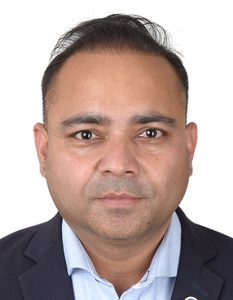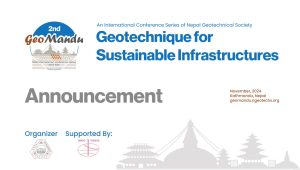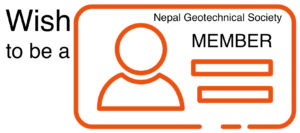Seniors’ Insight: NGS Interview Series 2

An Interview Series with Senior Members of Nepal Geotechnical Society
Prof. Dr. Madan B. Karkee, (Seattle, USA), Past President (1999-2002), Nepal Geotechnical Society; Currently: Professional Engineer (geotechnical engineering and seismic design)
 Profile:
Profile:
Place of Birth: Sankhuwa Sava, Nepal
Current Residence: Seattle, WA, USA
Academic career:
1978: Bachelor’s Degree (Civil Engineering), I. I. T. Kharagpur, India
1983: Master’s Degree (Structural Engineering), University of Hawaii, USA
1993: Ph.D. (Geotechnical Engineering), Tohoku University, Japan
Professional career:
1978-1993: Lecturer/Reader, Institute of Engineering, Nepal
1993-1999: Research and Development Manager, Geotop Corporation, Japan
1999-2007: Professor, Akita Prefectural University, Japan
2007-2010: Senior Geotechnical Engineer, Trow Associates, Canada
2010- (continue): Hart Crowser Inc., USA
Major engineering projects involved: Longest floating bridge in Lake Washington, largest diameter bored tunnel in Seattle, Light rail projects, several tall buildings with deep excavations, etc.
Number of publications: Over 100 including journals and conference proceedings
Q1: Sir, first of all, could you please briefly tell us about yourself and your current job responsibilities?
 Following my B.Tech (Hons) from IIT Kharagpur (India), I started my engineering career as a lecturer of civil engineering at Institute of Engineering (IOE), Tribhuvan University. At the time, my focus was on structural engineering and the opportunity to practice at IOE Consultancy Services complemented my teaching job. Subsequently, I completed my MS in Civil Engineering with a focus on structures from University of Hawaii (USA), where and when I got interested in soil-structure interaction (SSI) effects under earthquake shaking. My interest in SSI is what led to my deeper interest in geotechnical engineering, and then to my primary focus for my Ph.D. at Tohoku University, Japan.
Following my B.Tech (Hons) from IIT Kharagpur (India), I started my engineering career as a lecturer of civil engineering at Institute of Engineering (IOE), Tribhuvan University. At the time, my focus was on structural engineering and the opportunity to practice at IOE Consultancy Services complemented my teaching job. Subsequently, I completed my MS in Civil Engineering with a focus on structures from University of Hawaii (USA), where and when I got interested in soil-structure interaction (SSI) effects under earthquake shaking. My interest in SSI is what led to my deeper interest in geotechnical engineering, and then to my primary focus for my Ph.D. at Tohoku University, Japan.
I continued to pursue my interest in teaching and research as a professor at Akita Prefectural University in Japan until the end of 2006 when I needed to move to North America due to family situation. Currently, I am practicing as a professional engineer in the area of geotechnical engineering and seismic design. (*Photo: Prof. Karkee responds to then King Birendra’s query during IoE, Pulchowk Campus time)
Q2: We have come to know that when you were working in Japan, you served as the first President of Nepal Geotechnical Society back in 1999-2002. How did it come to you and how difficult it was to lead a then recently established society of only a few tens of members who were mostly residing abroad?
 The formative years of NGS were challenging because it was initiated by a small group of geotechnical engineers based in Japan at the time, with the aim of establishing it in Nepal at the earliest possible. The group contributed to a petty cash fund and Dr. Gyaneswor Pokherel was taking the lead in registering the organization in Nepal, while the group as a whole was working to establish NGS in the ISSMGE setup. At some point, I ended up being the consensus candidate to serve as the president. (*Photo: Prof. Karkee with a then ministerial delegation to Japan led by Minister Sharat Singh Bhandari and with the Japanese counterpart)
The formative years of NGS were challenging because it was initiated by a small group of geotechnical engineers based in Japan at the time, with the aim of establishing it in Nepal at the earliest possible. The group contributed to a petty cash fund and Dr. Gyaneswor Pokherel was taking the lead in registering the organization in Nepal, while the group as a whole was working to establish NGS in the ISSMGE setup. At some point, I ended up being the consensus candidate to serve as the president. (*Photo: Prof. Karkee with a then ministerial delegation to Japan led by Minister Sharat Singh Bhandari and with the Japanese counterpart)
 Our priority in those days was to continue with our effort to have NGS fully established in Nepal while contributing to ISSMGE activities as a new and enthusiastic country member. We also tried our best to have Nepal based geotechnical engineers participate in ISSMGE activities. Since most of the Nepal based geotechnical engineers at the time were at the start of their professional career, we focused on having them participate in the Young Geotechnical Engineers Conferences. (*Photo: Then Nepalese Ambassador to Japan Prof. Kedar Bhakta Mathema speaks to Nepalese geotechnical engineers in Japan including Prof. Karkee)
Our priority in those days was to continue with our effort to have NGS fully established in Nepal while contributing to ISSMGE activities as a new and enthusiastic country member. We also tried our best to have Nepal based geotechnical engineers participate in ISSMGE activities. Since most of the Nepal based geotechnical engineers at the time were at the start of their professional career, we focused on having them participate in the Young Geotechnical Engineers Conferences. (*Photo: Then Nepalese Ambassador to Japan Prof. Kedar Bhakta Mathema speaks to Nepalese geotechnical engineers in Japan including Prof. Karkee)
Q3: As an academician, a researcher, and a professional engineer, have you found any changes in perception of the field of geotechnical engineering in Nepal then and now?
I think the geotechnical engineering profession has plenty of potential for development in Nepal. I remember from my young engineer days at IOE that there was almost a complete lack of societal recognition for geotechnical engineering practice. The profession has come a long way since those days. However, the learning is a continuous process and we engineers also need to continuously strive to educate the society. To some extent, the 2015 earthquake disaster might have been eventful for the societal recognition of the geotechnical engineering profession in Nepal. I also remember reading about the construction excavation failure in Naxal in 2017. While such events are tragic and painful, the only way to prevent them from happening again is to learn from them and educate society.
Q4: Last year, we celebrated the 25th anniversary of NGS. How do you think NGS has achieved and should put more efforts to achieve its professional goals in these 26 years and in the years ahead?
While being professionally active in national, regional, and international societies, I think some of the important roles NGS can play include educating the society, developing standards of practice, observe/investigate and document geotechnical failures and natural disasters, develop and maintain local geotechnical database systems, etc.
Q5: We feel that in terms of membership strength and national and international activities and recognition, NGS has had a very slow growth in these 20-25 years compared to any similar ISSMGE national society. We have also come to know that many of the senior members of NGS, including you, who were very active in the past have now left Nepal and have been residing abroad. Do you think this is one of the strong reasons for less development of NGS and its activities in Nepal leading to the yet-to-be-recognized status of the geotechnical engineering field in the country?
 In general, every professional growth process suffers from some inertia of rest syndrome before they reach some escape velocity stage, and the potential energy in NGS accumulated over the years may be preparing it for that escape velocity stage. I am very hopeful about the future of NGS.
In general, every professional growth process suffers from some inertia of rest syndrome before they reach some escape velocity stage, and the potential energy in NGS accumulated over the years may be preparing it for that escape velocity stage. I am very hopeful about the future of NGS.
 About many of the senior members of NGS practicing the profession away from home, I think this can be looked as a double-edged sword. While their absence may cut into their potential local professional contributions, they are also an avenue to bring back constructive input from their experiences and to provide novel perspectives for adaptation. Overall, the international geotechnical community is not huge comparatively and tends to be rather close-knit in nature. Those of us with NGS affiliation but currently away from the homeland are and will remain close-knit NGS family. As for societal recognition in Nepal, I think NGS can help society help itself through awareness initiatives. (*Photos: Prof. Karkee presents a paper and then sits for a panel discussion during a geotechnical seminar held in Belgium)
About many of the senior members of NGS practicing the profession away from home, I think this can be looked as a double-edged sword. While their absence may cut into their potential local professional contributions, they are also an avenue to bring back constructive input from their experiences and to provide novel perspectives for adaptation. Overall, the international geotechnical community is not huge comparatively and tends to be rather close-knit in nature. Those of us with NGS affiliation but currently away from the homeland are and will remain close-knit NGS family. As for societal recognition in Nepal, I think NGS can help society help itself through awareness initiatives. (*Photos: Prof. Karkee presents a paper and then sits for a panel discussion during a geotechnical seminar held in Belgium)
Q6: How do you think senior members and academic and professional leaders like you, who are now stationed abroad and work in world-class geotechnical engineering projects can help NGS do much better in the homeland?
I think there are many NGS affiliated professionals currently in different parts of the world who would be willing to help and contribute to the continued development of the geotechnical engineering profession in Nepal. I think NGS should use this pool of out of station professionals to its advantage, and even try to widen the pool to encompass those without current NGS affiliation. I do not think it unusual for geotechnical engineers to be active members of multiple national societies.
Q7: We have also come to know that you studied in India, taught at Tribhuvan University, studied in the USA and Japan, and also worked in Japan, and are now working in the USA. How would you like to share your experience in studying and working in various countries with our young engineers and geoscientists?
 Thank you for tracking this bit of my background. Personally, this journey was full of challenges but also gratifying. Challenging because of the need to deal with changing circumstances, cultures, languages, practices, etc. and gratifying because of the lessons learned from pretty much the same reasons. As for my family, I feel that I had to drag them along my journey. My children had to repeatedly move away from the friends they had made and struggle to make new friends as their schools changed frequently from their formative days. (*Photo: Prof. Karkee and his research team observe a construction site in Japan)
Thank you for tracking this bit of my background. Personally, this journey was full of challenges but also gratifying. Challenging because of the need to deal with changing circumstances, cultures, languages, practices, etc. and gratifying because of the lessons learned from pretty much the same reasons. As for my family, I feel that I had to drag them along my journey. My children had to repeatedly move away from the friends they had made and struggle to make new friends as their schools changed frequently from their formative days. (*Photo: Prof. Karkee and his research team observe a construction site in Japan)
Q8: How important do you think the field of geotechnical engineering is in Nepal in the context of building earthquake-resistant infrastructures and disaster-resistant/resilient societies?
In this context, my interest in SSI (soil-structure interaction) and the reason why I transitioned to geotechnical engineering after starting as a structural engineer may have some relevance. The local ground shaking where the structure is founded, as well as the earthquake-induced geotechnical hazards at the specific location, contribute to structural responses during the earthquakes. Obviously, geotechnical engineers are who we need to assess and characterize those local conditions and work with structural engineers to design safe and resilient infrastructure.
Q9: Finally, would like to say anything further to all NGS community?
I wish the very best for the continuous growth and expansion of geotechnical engineering professionals under the NGS umbrella in Nepal. I also look forward to future opportunities to interact and learn from all of you in the NGS family.
Thank you and we wish you all the best!






